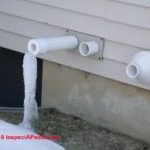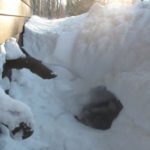 Direct vent heating systems are the ones that run so efficiently that they can vent through a PVC pipe instead of a chimney. Why does the efficiency matter? If the air coming out of the boiler is still very hot, it cannot travel through plastic PVC pipes. Newer high-efficiency boilers and hot water heaters use less fuel because most of the heat they generate goes into your house, not up your chimney.
Direct vent heating systems are the ones that run so efficiently that they can vent through a PVC pipe instead of a chimney. Why does the efficiency matter? If the air coming out of the boiler is still very hot, it cannot travel through plastic PVC pipes. Newer high-efficiency boilers and hot water heaters use less fuel because most of the heat they generate goes into your house, not up your chimney.
When your system was installed, a hard-wired CO detector was installed, too. That’s code. There was also supposed to be a sign posted near your vents, saying keep these vents clear of snow. Home inspectors frequently note that those signs are missing.
Code:
INSTALLATION OF CARBON MONOXIDE DETECTORS. At the time of installation of the side wall horizontal vented gas fueled equipment, the installing plumber or gasfitter shall observe that a hard wired carbon monoxide detector with an alarm and battery back-up is installed on the floor level where the gas equipment is to be installed. In addition, the installing plumber or gasfitter shall observe that a battery operated or hard wired carbon monoxide detector with an alarm is installed on each additional level of the dwelling, building or structure served by the side wall horizontal vented gas fueled equipment. It shall be the responsibility of the property owner to secure the service of qualified licensed professionals for the installation of hard wired carbon monoxide detectors source [emphasis mine]
 Why do you keep snow away from these vents?
Why do you keep snow away from these vents?
If snow collects and cuts off air supply to your direct vent boiler, your heat will turn off. In our area, these vents are installed a foot, or more, off the ground. It is the rare winter where there is more than a foot of snow on the ground here, although 2015 comes to mind! Most of the time, if the vents are blocked by snow, the occupants of the house find out because the system shut down and it’s cold. But, carbon monoxide can collect outside the house. If the easiest place for air flow to go is back into the basement, then CO can get into the house. This would happen if there is an air pocket against the house under a snowbank. It is dangerous, and possible, but unlikely to happen. source
Safety measures.
Vents:
- When the weather is fair, find your vent locations.
- When there is snow, check that they remain above the snowline. Shovel them out if they get covered.
Detectors:
- Homeowners are responsible for the upkeep of CO and smoke detectors. At the time of purchase, houses and condos are inspected by the local fire department and certified as having the correct type and placement of smoke and CO detectors.
- If you bought your house or condo before 2006, add carbon monoxide detection that is required now, but was not when you purchases.
- If you bought your house or condo before 2018, change out your smoke detectors to the ones with 10-year non-replaceable batteries. This is the new code. Having smoke detectors won’t help you if you pull the batteries out when they chirp and don’t replace them. Now, you can’t tamper with them and that makes them safer. Also, the sell some that are less sensitive to temperature change, so you don’t have to hear them go off while you pre-heat the oven.
Unnecessary fear.
High-efficiency boilers are installed with safety features that will turn them off if their vents are blocked. The new installations require CO detectors that are hard-wired with battery back-up. They are unlikely to cause CO poisoning.
Chimneys, however, can get blocked by bird’s nests, raccoons, and other animals. They can also get blocked by bricks falling because of worn-out mortar. Older boiler installations did not require CO detector installation. So, the chances of carbon monoxide poisoning are higher with older heating systems that use chimneys. Your best protection is to have functioning CO detectors, as required by law, in your house or condo.
Have a safe and lovely winter.

Leave A Comment